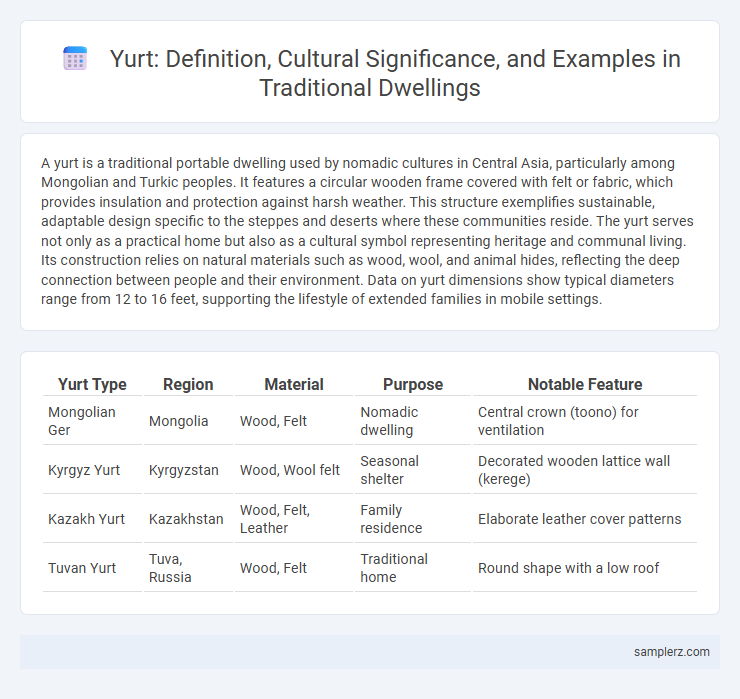A yurt is a traditional portable dwelling used by nomadic cultures in Central Asia, particularly among Mongolian and Turkic peoples. It features a circular wooden frame covered with felt or fabric, which provides insulation and protection against harsh weather. This structure exemplifies sustainable, adaptable design specific to the steppes and deserts where these communities reside. The yurt serves not only as a practical home but also as a cultural symbol representing heritage and communal living. Its construction relies on natural materials such as wood, wool, and animal hides, reflecting the deep connection between people and their environment. Data on yurt dimensions show typical diameters range from 12 to 16 feet, supporting the lifestyle of extended families in mobile settings.
Table of Comparison
| Yurt Type | Region | Material | Purpose | Notable Feature |
|---|---|---|---|---|
| Mongolian Ger | Mongolia | Wood, Felt | Nomadic dwelling | Central crown (toono) for ventilation |
| Kyrgyz Yurt | Kyrgyzstan | Wood, Wool felt | Seasonal shelter | Decorated wooden lattice wall (kerege) |
| Kazakh Yurt | Kazakhstan | Wood, Felt, Leather | Family residence | Elaborate leather cover patterns |
| Tuvan Yurt | Tuva, Russia | Wood, Felt | Traditional home | Round shape with a low roof |
Introduction to Yurts as Traditional Dwellings
Yurts are traditional portable round tents used by nomadic cultures in Central Asia, particularly among Mongolian and Turkic peoples. Constructed with a wooden frame and covered with felt or fabric, yurts provide durable, insulated shelter suitable for harsh climates and seasonal mobility. Their design emphasizes efficient use of space, ventilation, and ease of assembly, reflecting centuries of cultural adaptation to nomadic lifestyles.
Historical Origins of Yurt Architecture
Yurt architecture originated over 3,000 years ago among the nomadic tribes of Central Asia, particularly the Mongols and Turkic peoples. These portable, circular dwellings were designed to withstand harsh climates with a wooden frame covered by felt and canvas. The structure's flexibility and insulation reflect centuries of adaptation to the steppes' extreme weather, embodying a unique blend of functionality and cultural heritage.
Cultural Significance of Yurts in Central Asia
Yurts, traditional portable round tents used by nomadic peoples in Central Asia, hold profound cultural significance as symbols of community, mobility, and harmony with nature. These structures embody centuries of heritage, reflecting the ingenuity of Turkic and Mongolian cultures in adapting to harsh climates while fostering social cohesion. Yurts serve not only as practical dwellings but also as sacred spaces for ceremonies, storytelling, and preserving oral traditions.
Materials and Construction Techniques of Yurts
Yurts are traditionally made using a wooden frame of lattice walls, roof poles, and a central compression ring, covered with layers of felt made from sheep's wool for insulation and canvas or animal hides for waterproofing. The materials are lightweight and locally sourced, allowing for easy assembly, disassembly, and portability, which suits the nomadic lifestyle of Central Asian cultures. Innovative construction techniques include tension bands to maintain structural integrity and the use of overlapping felt layers to regulate temperature and protect from harsh weather conditions.
Symbolism and Ornamentation in Yurt Design
Yurt design embodies rich symbolism through its circular shape, representing unity and harmony in nomadic cultures. The ornamental patterns often feature motifs such as the "ulzii," symbolizing protection and eternity, meticulously hand-painted or embroidered on the yurt's interior and outer walls. These designs not only enhance aesthetic appeal but also convey cultural identity and spiritual beliefs embedded in traditional dwelling practices.
Daily Life Inside a Yurt: Social and Cultural Practices
Daily life inside a yurt centers around communal activities that reinforce social bonds and cultural traditions, with families gathering around the central hearth for meals and storytelling. The yurt's circular design fosters equality and unity, facilitating ritual ceremonies and seasonal festivals that link inhabitants to their ancestral heritage. Practical arrangements within the yurt reflect nomadic customs, where multifunctional spaces adapt to daily tasks such as cooking, sleeping, and handicraft production, preserving cultural identity through everyday practices.
Yurts in Modern Nomadic Communities
Yurts remain a vital dwelling for modern nomadic communities across Central Asia, offering portability and resilience suited to harsh climates. These circular, portable tents are constructed with a wooden frame and felt coverings, providing insulation and ventilation essential for varied seasonal conditions. Contemporary adaptations integrate solar panels and durable synthetic materials, enhancing comfort while preserving traditional design principles.
Adaptation of Yurts in Contemporary Living
Yurts, traditionally portable round tents used by nomadic cultures in Central Asia, have been adapted for contemporary living as eco-friendly and sustainable dwellings. Modern yurts incorporate materials like insulated panels, solar power, and contemporary heating solutions, making them suitable for year-round habitation. This adaptation reflects a growing trend toward minimalist lifestyles and sustainable architecture in global housing markets.
Yurts in Festivals and Cultural Heritage Events
Yurts serve as iconic cultural symbols in festivals and heritage events across Central Asia, showcasing traditional nomadic architecture and craftsmanship. These portable, round tents feature a wooden frame and felt covering, providing a connection to ancestral lifestyles and communal gatherings. Their presence at cultural events emphasizes the preservation of history and the celebration of ethnic identity through immersive, authentic environments.
Preservation Efforts for Yurt Traditions
Preservation efforts for yurt traditions emphasize the use of authentic materials such as felt and wood, ensuring the structural integrity and cultural authenticity of these portable dwellings. Cultural organizations and local communities collaborate to conduct workshops and festivals that teach traditional yurt construction techniques and symbolic designs. Documentation of yurt heritage through multimedia archives strengthens the transmission of knowledge and promotes global awareness of this nomadic architectural treasure.

example of yurt in dwelling Infographic
 samplerz.com
samplerz.com